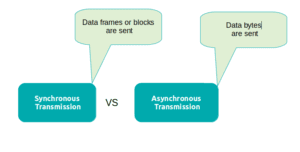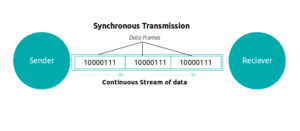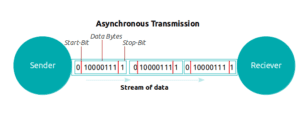The transmission that emphasises on transmitting data bit by bit is known as Serial Data Transmission. This serial transmission is of two types:
- Synchronous data transmission
- Asynchronous data transmission

Both are data transmission methods and both have their own significance.
The major difference between them is, synchronous transmission maintains an external clock to make sender and receiver synchronised before transferring data, whereas, the asynchronous transmission uses start and stop bits to identify the correct order of data before transmission starts.
Difference between Synchronous and Asynchronous transmission
| SYNCHRONOUS TRANSMISSION | ASYNCHRONOUS TRANSMISSION |
|---|---|
| In Synchronous data transmission, the data is sent in the form of frames or blocks | In this data transmission, the data is transmitted in the form of a Character or Byte |
| Synchronous data transmission is faster as compared to Asynchronous data transmission | Asynchronous data transmission is comparatively slower than Synchronous data transmission |
| A constant time interval is followed | There is no time interval to be followed |
| It is very expensive | Asynchronous data transmission is quite economical |
| This type of transmission can be implemented for data transmission through both hardware and software | This type of transmission can be implemented for data transmission through hardware only |
| If we take synchronous transmission into consideration then, in this type of data transmission there is an urgent requirement for both the sender and receiver to have a synchronized clock | If we take asynchronous transmission into consideration then, in this type of data transmission there is no need for the sender or receiver to have a synchronized clock |
| No gap between data is exist | Gap between data is exist |
| Chat rooms and telephonic conversations are some examples | E-mails and Letters are some examples |
Synchronous Data Transmission
Synchronous refers to “appearing at same time”.
Similarly, throughout the transmission both sender and receiver are synchronised.
The type of transmission in which there is a continuous stream of data signals coupled with time-based signals for an efficient data transfer is called Synchronous Data transmission. It provides full duplex type transmission to deliver data frames.
This transmission is done to ensure that the transmitters, as well as the receiver, are in coordination with each other.

In case of synchronous transmission, there is greater need to firstly have synchronized clock with both the sender as well as the receiver before actual data transmission.
It uses an external clock in order to ensure both sender and receiver are synchronised. Both uses that particular common clock. It maintains a fixed time interval to transmit data frames.
It is suitable for delivering a large amount of data. These data bytes are followed by a special character called ‘syn’ which is used to make the connection synchronised.
Asynchronous Data Transmission
The type of transmission in which there is a voluntary start bit is sent to mark the beginning of a data transfer is called Asynchronous data transmission.
In this transmission, the whole process of data transfer is governed by the start and stop bits.

There is no need to have synchronized clocks but there is an addition of the parity bit to the actual data before the transmission happens.
In this type of transmission, data bytes are transmitted bit by bit commonly having 8 bits of characters with the special bits. It provides half-duplex type transmission to deliver data bytes.
To identify the correct order of a sequence of data, these two special bits are used.
The two bits is stop bit represented by 1 and start bit by 0, also known as partial bits. To achieve this type of transmission, stop-bit and start-bit is sent along with data bytes through the transmission medium.


